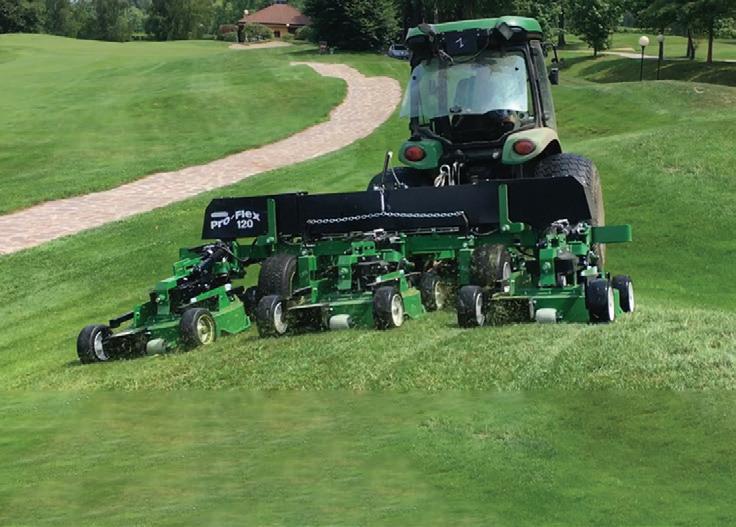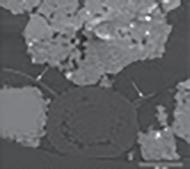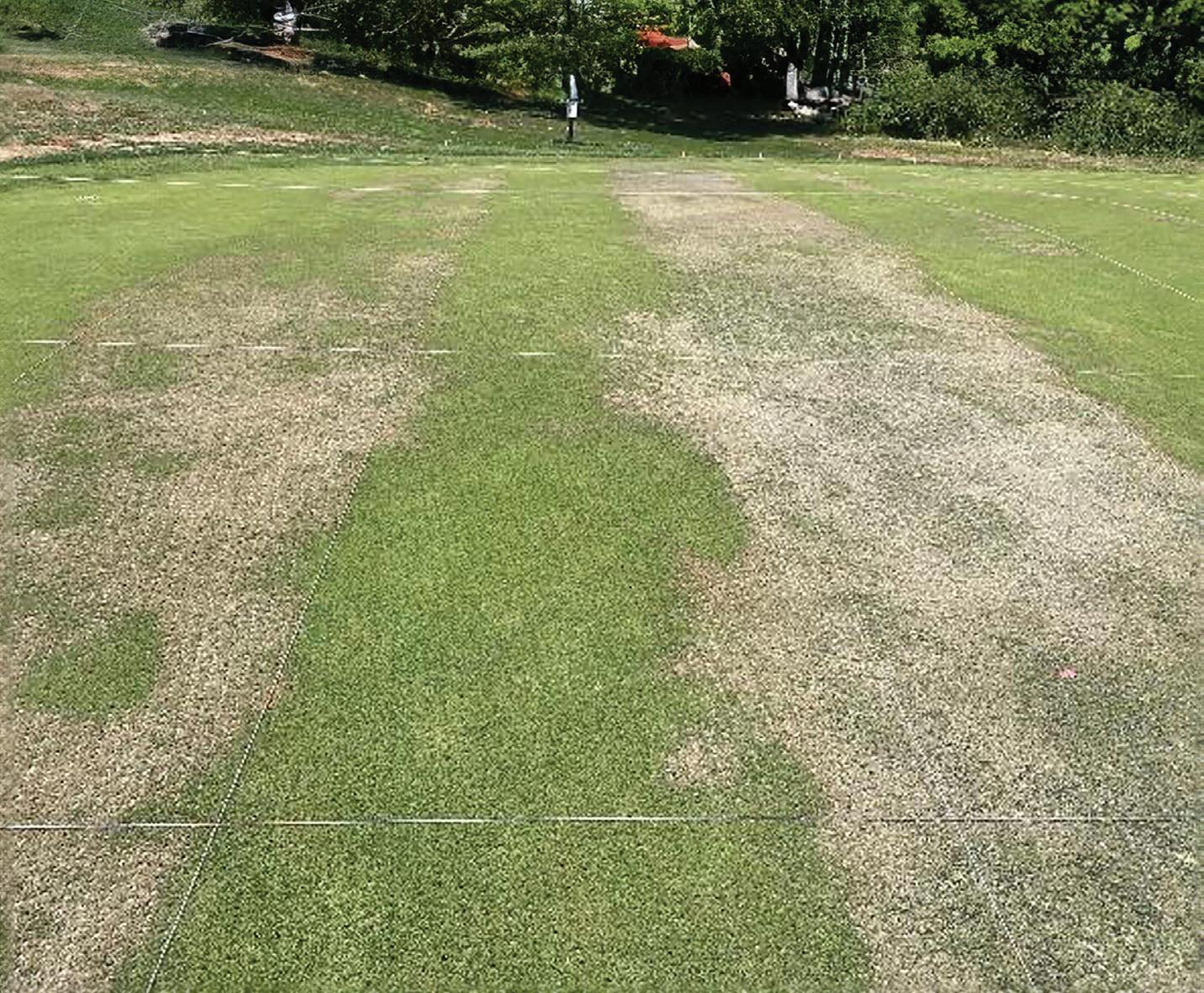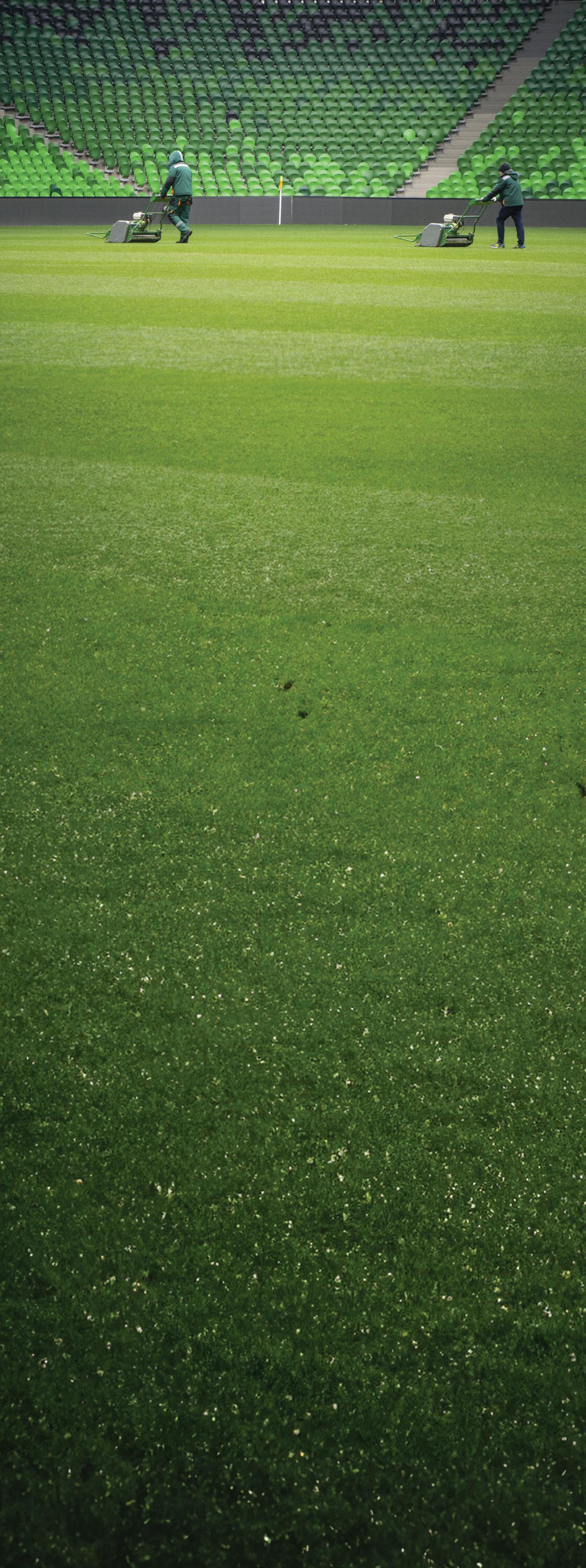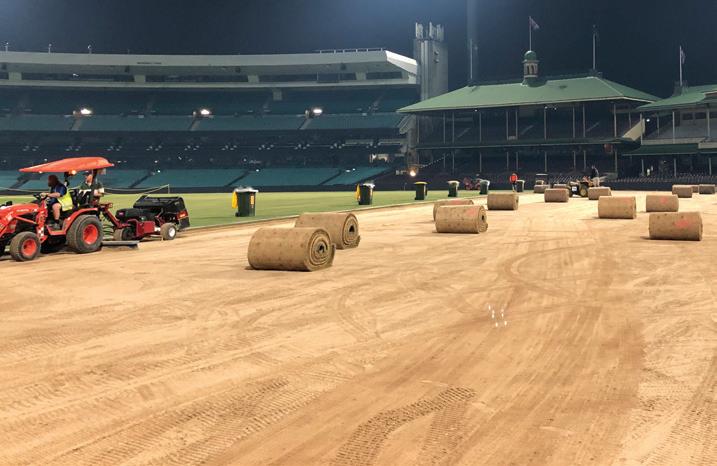In Control of YELLOW and KNOTROOT FOXTAIL in Southern Turfgrass
the southeastern region of the United States, Setaria pumila and Setaria parviflora, respectively known as yellow and knotroot foxtail, are two common species infesting managed and unmanaged turfgrass, pastures, roadsides, and some cropping systems (Bryson and DeFelice, 2009; Hitchcock, 1971). Yellow and knotroot foxtail originated from Asia and North America, respectively (Dekker, 2003; Rominger, 1962a). Nevertheless, they are very similar in appearance and are frequently mistaken for each other, leading to confusion in herbicide selection (Darmency and Dekker, 2011).
The primary differences between yellow and knotroot foxtail are found in the seedhead with yellow foxtail seedheads bigger and denser with more hairs (Darmency and Dekker, 2011). Other studies found that knotroot foxtail can be differentiated from yellow by the presence of rhizomes (Wang et al., 1995). However, since these characteristics appear late during development or sometimes are not apparent at all, it is very difficult to tell the two species apart in the field (Wang et al., 1995).
Yellow and knotroot foxtail are annual and perennial weeds, respectively, with few options for effective chemical control in
warm-season turfgrass. Pinoxaden is labeled in the United States for use on bermudagrass controls of yellow foxtail post emergence (Peppers et al., 2020), but pinoxaden is not labeled to control knotroot foxtail (Peppers et al., 2020). Chlorsulfuron gave season-long control of yellow foxtail when applied at the early growth stage in Kentucky bluegrass, but it is not labeled in turfgrass (Maloy, 1985). Imazethapyr controls yellow foxtail effectively as a preemergence with no detrimental effects on grass establishment (Fry et al., 1997).
Little research has been done to gain an understanding of the chemical control of knotroot foxtail. In pastures, hexazinone alone or applied with metsulfuron + dicamba + 2,4-D, controlled knotroot foxtail by more than 70% two weeks after application, as did chlorsulfuron or nicosulfuron (Coats et al., 1999). Nicosulfuron + metsulfuron controls knotroot foxtail 70% in bermudagrass forage at the actively growing stage (Rusell, 2021).
Other herbicides could potentially control yellow and knotroot foxtail but are not currently labeled. For instance, thiencarbazone + dicamba + iodosulfuron is labeled for controlling yellow foxtail and giant foxtail but not knotroot foxtail.
The objectives of this research were to (1) evaluate the response of yellow foxtail and knotroot foxtail to several turfgrass herbicides and (2) evaluate the rate response of yellow and knotroot foxtail to increasing rates of pinoxaden and sethoxydim and estimate the application rate at which 50% (I50) of both species was injured.
Material and Methods
Research was conducted in 2021 and 2022 in greenhouse populations to evaluate yellow and knotroot foxtail response to different turfgrass herbicides. Two experiments were conducted at the Auburn University Weed Science greenhouse in Auburn, AL in 32/28 C (+/-1 C Day/night) conditions with an average relative humidity of 70%. Seeds of both species were harvested from a local population in Montgomery, Alabama. Seeds were cleaned and stored at 4oC prior to the experiments. Seeds were planted in flats of potting medium and were then transplanted individually at three leaves stage into 230 cm3 pots, filled with sandy soil. Treatments were applied two weeks after transplantation. After treatment, pots were not watered for approximately 24 hours to allow for adequate leaf absorption. See Figure 1 for the herbicide treatments.
Celsius (Thiencarbazone+Dicamba+lodosulfuron)
(Metribuzin)
Steadfast (Nicosulfuron +Rimsulfuron)
FMC (Sulfentrazone) 0.841
Dismiss South (Sulfentrazone +Imazethapyr)
Scepter (Imazaquin)
Figure 1. Herbicide treatments applied to yellow and knotroot foxtail in this study
Setaria pumila, yellow foxtail,.
The treatments were evaluated for percent weed control at 7, 21 and 28 days after application (DAA) and above ground biomass of the foxtail plants were evaluated at 28 DAA.
Results and Discussion
In greenhouse evaluation, yellow and knotroot foxtail responded differently to the selected herbicides. All the herbicides were effective on yellow foxtail with more than 85 % at 28 days after application (DAA) (Figure 2). Above-ground biomass data followed the same pattern. All the herbicides reduced yellow foxtail above-ground biomass by more than 95% compared to the nontreated at 28 DAA.
Knotroot foxtail was more difficult to control in general than yellow foxtail. Sulfentrazone controlled knotroot foxtail > 90 %, which was the best treatment statistically. Similarly, metribuzin controlled knotroot foxtail 81%, imazaquin 71%, sethoxydim (high rate) 76%, and thiencarbazone + dicamba + iodosulfuron 68% control (Figure 2). All the other treatments controlled knotroot foxtail by less than 65%. Relative plant fresh-weight data agreed with visually estimated control data. Sulfentrazone, metribuzin, sethoxydim (high rate), thiencarbazone+dicamba+iodo sulfuron and imazaquin reduced the above ground biomass by more than 90% and nicosulfuron+rimsulfuron reduced knotroot foxtail biomass by 89%. However, pinoxaden (low and high rates) were less effective on knotroot foxtail with less than 30% biomass reduction.
Bottom Line
This study found that yellow foxtail responded differently to herbicides than knotroot foxtail, and knotroot foxtail was more difficult to control. Based on the greenhouse studies, sulfentrazone, sethoxydim (high rate) thiencarbazone + dicamba + iodosulfuron, and metribuzin can be considered for controlling yellow and
Figure 2. Control of yellow foxtail with various herbicide treatments at 7, 21 and 28 days after application (DAA)
Figure 3. Control of knotroot foxtail with various herbicide treatments at 7, 21 and 28 days after application (DAA)
knotroot foxtail at label rates. Knotroot foxtail response was more variable and pinoxaden should not be considered for controlling knotroot foxtail even at the maximum recommended label rate. Sethoxydim provided effective control of yellow foxtail and reduced knotroot foxtail biomass by more than 60% at the labeled rate. Responses observed in this study suggest that differentiation between yellow and knotroot foxtail is essential for predictable results with herbicides.
Literature Cited
Bryson CT, DeFelice MS (2009) Weeds of the south Athens, GA: University of Georgia Press. Pp. 495
Coats GE, Taylor JM, Kelly ST, Helms RB, Scott TD (1999) Highway vegetation management Mississippi: Miss. Agric. and Forest. 122 p
Darmency H, Dekker J (2011) Setaria. Pages 275291 in Kole C, ed. Wild Crop Relatives : Genomic and Breeding Resources. Clemson: Springer
Dekker J (2003) The foxtail (Setaria) speciesgroup. Weed Science 51:641-656
Dyer LM, Henry GM, McCullough PE, Belcher J, Basinger NT (2022) Knotroot Foxtail [Setaria parviflora (Poir.) Kerguélen]:“A sly fox”. Weed Technology:1-22
Fry JD, Gaussoin RE, Beran DD, Masters RA (1997) Buffalograss Establishment with Preemergence Herbicides. Hortscience 34
Hitchcock AS (1971) Manual of the grasses of the United States. New york: Dover
Kotu V, Deshpande B (2018) Data science: concepts and practice: Morgan Kaufmann
Maloy BM (1985) Selective control of perennial grasses in Kentucky 21 blue-grass (Poa pratensis L.) turf with chlorsulfuron. Master of science Iowa Iowa State University
Ogle DH, Doll JC, Wheeler P, Dinno A (2022) FSA: Fisheries Stock Analysis
Peppers JM, Gonçalves CG, McElroy JS (2020) Rate response of select grass weeds to pinoxaden. Weed Technology 34:818-823
Ritz C, Baty F, Streibig J, Streibig C, Gerhar D (2015) Dose-Response Analysis Using R. PLOS ONE 10
Rominger JM (1962) Taxonomy of Setaria (Gramineae) in North America in Press TUoI, ed. Urbana
Rusell D (2021) Widespread Foxtail Distribution Leads to Tough Management Decisions. Forages
Wang RL, Wendel JF, Dekker JH (1995) Weedy adaptation in Setaria spp II Genetic diversity and population genetic. American Journal of Botany 82:1031-1039 •
Specialty Distribution
Rodney Fisher
Email: agrarod@yahoo.com
Figure 4. Yellow (top) and knotroot (bottom) foxtail plants at 28 days after herbicide application
BIOSTIMULANTS TURFGRASS MANAGEMENT for Considerations with
By Mike Fidanza, Ph.D. – Professor of Plant and Soil Science, Penn State Berks Campus; Reading, PA (maf100@psu.edu)
The term “biostimulant” has been misunderstood, misused, or misplaced as a potential “miracle cure” in the turfgrass industry, and biostimulant products were often dismissed as “snake oil” or “foo-foo juice” (e.g., sarcastic reference to the mythical foo-foo tree). Some biostimulant products make performance claims substantiated with scientific research, while other products lack direct evidence of their actual benefit.
Dr. Richard Schmidt (Emeritus Professor at Virginia Tech; Blacksburg, VA; and Penn State alum) is considered the pioneer of biostimulant research in turfgrass science. Dr. Schmidt defined biostimulants as follows: “Biostimulants are organic materials that when applied in small or minute quantities enhance plant growth and development.” The use of the word “minute” in this definition is intended to differentiate the fact that these substances, compared to traditional nutrients and/or soil amendments, elicited a measurable and beneficial response at much lower application rates. In his early work, Dr. Schmidt considered the plant biostimulant effect was attributed to a hormonal response and the plant protection effect against abiotic stress as attributed to antioxidant production, and both of those effects made possible from low concentrations of exogenous applications. Dr. Schmidt also used the term “metabolic enhancers,” but the important distinction was that something positive was happening to the plant beyond what mineral nutrition supplied.
More recently, plant biostimulant is defined as “any substance or microorganism applied to plants with the aim to enhance nutrition efficiency, abiotic stress tolerance, and/or crop quality traits, regardless of nutrient content.” The term “plant biostimulant” often is used to describe the various categories of compounds and substances used in these products: plant growth hormones (e.g., abscisic acid, auxins, cytokinins, gibberellic acid, etc.), microorganisms (e.g., Bacillus spp., Trichoderma spp., mycorrhizae, etc.), amino acids, humic and fulvic acids, plant defense-activating substances, plant growth-promoting compounds, vitamins, pigments and oils, soil amendments and soil conditioners, composts and compost teas, and more.
The European Biostimulant Industry Council (EBIC; https:// biostimulants.eu) defines biostimulants as: “Agricultural biostimulants include diverse formulations of compounds, substances, and other products that are applied to plants or soils to regulate and enhance the crop’s physiological processes, thus making them more efficient; biostimulants act on plant physiology through different pathways than nutrients to improve crop vigor, yields, quality and post-harvest shelf life/conservation.” The EBIC also has a functional definition of plant biostimulants as follows: “A material which contains substance(s) and/or microorganisms whose function, when applied to plants or the rhizosphere, is to stimulate natural processes to benefit nutrient uptake, nutrient efficiency, tolerance to abiotic stress, and/or crop quality, independently of its nutrient content.” Of note, the EBIC’s functional definition expands beyond the ‘plant’ to also include the ‘soil’ (e.g., rhizosphere).
The Association of American Plant Food Control Officials (AAPFCO; https://aapfco.org) defines biostimulants as: “Any substance or compound other than primary (e.g., N, P, and K), secondary (e.g., Ca, Mg, S), and microplant nutrients (e.g., Fe, Cu, etc.), that can be demonstrated by scientific research to be beneficial to one or more plant species when applied exogenously; …a substance or material, with the exception of nutrients or pesticides, which has the capacity to beneficially modify plant growth.” Of note, the ASPFCO definition of biostimulants refers to the term “beneficial substance.”
Biostimulants are often categorized by “what they are” (e.g., how are these substances or compounds or component materials described chemically or physically?) and “what they do” (e.g., how do these substances or compounds benefit the turfgrass plant or the turfgrass soil/rootzone?). The turfgrass practitioner and stakeholder would benefit from knowing not only what a biostimulant is actually composed of, but how those commercially available biostimulant products benefit turfgrass management programs. Therefore, a proposed classification method or strategy for listing biostimulants in turfgrass is presented in Table 1. Overall, biostimulants are listed as primarily targeting the plant or soil/rhizosphere, then further organized by category to describe their composition, followed-by active or functional ingredients (e.g., compounds, substances, other descriptive terms) listed within each category. Examples of common names for biostimulant products are listed for each category.
I. Phytohormones
Plant hormones or phytohormones are considered chemical messengers in plants. They are referred to as ‘signal molecules’ that occur in very low concentrations, and are vital to plant growth and development, and regulation and function of many physiological processes. The most common phytohormones utilized as plant biostimulants are abscisic acid, auxins, cytokinins, ethylene, and gibberellic acid.
Abscisic acid is associated with water regulation in plants and is associated with the plant’s ability to mitigate abiotic stress from drought, salinity and temperature. Auxin is responsible for phototropism (e.g., shoots growing upward, toward the light) and gravitropism (e.g., roots growing downward into the soil). Indole-3-acetic acid (IAA) is the most common naturally occurring auxin and included as the auxin component of many biostimulant products to promote root viability and drought tolerance. Cytokinins are involved with plant
growth and development and stress-response processes, and in particular with cell division and delaying of leaf senescence (e.g., plant senescence is the process of aging in plants; plants have both stress-induced and age-related developmental aging). This delay of leaf senescence or “stay green” effect is a plant stress response in which cytokinins inhibit the action of senescence-inducing enzymes, slowing the degradation of chlorophyll, and maintaining photosynthetic rates and root viability. An example of a commonly used biostimulant product in this category is seaweed extract, also referred to as seaplant or kelp. Gibberellic acid controls important plant growth functions such as cell elongation and stem growth, seed germination, flower development, and flowering time. While abscisic acid, auxin, cytokinin, and gibberellic acid exist in the plant in liquid form, ethylene is a gaseous phytohormone that regulates plant growth (e.g., the development of leaves, flowers, and fruits), senescence, response to environmental stresses (e.g., heat and freezing stresses), and often interacts with other phytohormones.
II. Biopolymers, protein hydrolysates, and other N-containing compounds
Examples of compounds in this category include amino acids, and they are considered the “building blocks” for proteins, enzymes, nucleic acids, antioxidants, and other secondary compounds. The L-form of amino acids are assimilated by plants, and these L-amino acids and short-chain peptides are reported to increase plant N uptake, increase root mass, activate natural defense mechanisms, and enhance photosynthesis.
III. Other botanical or synthetic bioactive compounds
This is a “placeholder” category for plant-directed compounds not yet described or fully understood, or for compounds that do not fit the description of the other categories. An example of an organic compound in his category is acibenzolar-S-methyl, which is a synthetic analog of salicylic acid and is referred to as a “plant defense activator” because it produces an induced systemic resistance response and thus activates a plant’s natural defense system.
IV. Humic substances
Humic substances (e.g., humic and fulvic acids) are natural decomposition constituents of soil organic matter, typically derived from leonardite (a natural form of humates), associated with “brown coal” deposits. Benefits of these compounds increased soil nutrient and water holding capacity (e.g., increased cation exchange capacity), prevention and reduction in leaching of soil nutrients, chelators of organic molecules and minerals facilitating increased plant root absorption, enhanced soil enzyme and metabolic activity.
V. Organics
Traditionally, organic amendments such as peat moss, manures, biosolids, composts, and other materials have been added to sand-based turfgrass rootzones to increase water and plant nutrient retention and availability. Ideally, organic materials and substances applied to turfgrass soils should be sufficiently decayed and biologically stable and decompose very slowly so their benefits or positive impact can be expressed over a long time.
Table 1. Proposed classification of biostimulants for turfgrass science and industry.
PLANT
Category 1 Examples of active or functional ingredients
Abscisic acid
Auxins
Cytokinins
I Phytohormones
Ethylene
Gibberellic acid
Others
Amino acids (e.g., proline, etc.)
Antioxidants
Betaines
Chitin
II Biopolymers, protein hydrolysates, and other N-containing compounds
Enzymes
Fatty acids
Non-protein amino acids
Peptides
Polyamines
Polysaccharides
Vitamins
III Other botanical or synthetic bioactive compounds
Examples of biostimulant products 2
algae, indoleacetic acid, benzyl-adenine, gibberellins, kelp, seaplant, seaweed extracts, and more
Others amino acids, chitosan, glycine betaine, and more
Elicitor compounds, Induced systemic resistance compounds,
Plant defense activator compounds,
Others acibenzolar-S-methyl, jasmonic acid, salicylic acid, and more
1 Category based on chemical and/or physical composition.
2 Broad or general name of a biostimulant product listed; no product trade name provided. Should an additional column list the specific biostimulant function of those biostimulant products, and/ or should the manufacturer include that information on their product label?
SOIL / RHIZOSPHERE
Category 1 Examples of active or functional ingredients
IV Humic substances
V Organics
VI Inorganics /minerals
Fulvic acid
Examples of biostimulant products 2
Humic acid leondardite, and more
Biochar
Bio-extracts
Bio-fertilizers
Composts/compost extracts
Soil amendments/supplements
Others
Al, Co, Na, Mo, Se, Si, etc.
Phosphites
biochar, composts, compost teas, kelp, seaplant, seaweed extracts, vermi/worm extracts, and more
Others phosphite salts, and more
Beneficial fungiArbuscular mycorrhizal fungi
Trichoderma spp.
Others
VII Biologicals/ microbials
Beneficial bacteriaBacillus spp. and other species
Plant growth promoting rhizobacteria
Others
Other beneficial organisms
Many
VIII Soil surfactants 3 --?-- --?--
IX Other naturally derived or synthetic bioactive compounds
Elicitor compounds
Induced systemic resistance compounds
Plant defense activator compounds
Others --?--
1 Category based on chemical and/or physical composition.
2 Broad or general name of a biostimulant product listed; no product trade name provided. Should an additional column list the specific biostimulant function of those biostimulant products, and/ or should the manufacturer include that information on their product label?
3 Proposed location of soil surfactants as a category if some of those soil surfactants are to be considered or included as biostimulants.
Recently, biochar has gained interest due to a high carbon content, porosity, and stability (e.g., extremely resistance to microbial degradation). Vermicompost extract also is popular for improving the biological and physical health of the turfgrass rootzone.
VI. Inorganics / minerals
Many inorganic/mineral compounds and products can be placed into this category. Phosphite (PO33-) of has become the most common inorganic compound incorporated into many turfgrass management programs, particularly with disease management and suppression.
VII. Biologicals / microbials
Numerous biological/microbial organisms can be placed into this category. Arbuscular mycorrhizal fungi form a mutually symbiotic relationship with plant roots, in which roots provide carbohydrates for the fungi and the fungi aid in access and transfer of nutrients and water to the plant roots, and also aid in water balance, and abiotic and biotic stress tolerance or protection. Bacillus spp. is the most common example of a bacterial organism utilized for biological control of plant pathogens, and this is achieved via direct suppression by the release of antipathogen compounds, or via indirect mechanism such as outcompeting the pathogen for space or food, or for activating or inducing plant defense systems. Current research is exploring plant growth promoting rhizobacteria and their ability to confer beneficial effects
Figure 1. An example of a beneficial application program of Excalibur soil surfactant (AquaAid Solutions; Rocky Mount, NC) on a creeping bentgrass putting green subjected to drought stress. The volumetric water content status of the rootzone was improved to optimize the function of the rhizosphere. A: Illustration depicting good or optimum root-to-soil contact in Excalibur-treated plot. B: Illustration depicting poor root-to-soil contact in untreated plot. C: Healthy and dense turfgrass visible within the plot, indicating good root-to-soil contact and access to water and nutrients. D: Drought stress visible within the plot, indicating roots with compromised physiological function.
Images in A and B from: Weil R.R. and Brady, N.C. 2017. The nature and properties of soils. 15th ed. Pearson Education, New York City, NY. Images in C and D from: Duddek, P., Carminati, A., Koebernick, N., Ohmann, L., Lovric, G., Delzon, S., Rodriguez – Dominguez, C., King, A., and Ahmed, M.A. 2022. The impact of drought-induced root and root hair shrinkage on root–soil contact. Plant Physiology 189:1232-1236.
on plant growth and development by increased nutrient uptake (e.g., nitrogen and phosphorus), synthesizing plant growth promoting compounds, activating abiotic and biotic stress tolerance mechanisms, and possibly more.
VIII. Soil surfactants
Agriculture, horticulture, and turfgrass industry practitioners commonly refer to soil surfactant products as “wetting agents.” Should all or some specific soil surfactants be listed as a biostimulant? Can soil surfactants “behave as biostimulants,” or “facilitate a biostimulant effect” when applied to turfgrass rootzones? Surfactants are primarily and traditionally used for water conservation, improving irrigation use efficiency, and ameliorating soil water repellency. The utilization of soil surfactants is considered the number one water conservation strategy among golf course superintendents in the USA. Current research indicates certain diverse rootzone processes can be “engineered” by surfactants to optimize rhizosphere and soil biophysical, microbiological, and chemical properties (Figure 1).
IX. Other naturally derived or synthetic bioactive compounds
This category is a “place-holder” for soil-directed compounds not yet described or fully understood, or for compounds that do not fit the description of the other categories.
Root Hairs Turgid
Root
Major Cortex Drying Root
Other Soil Surfactant Excalibur
Before considering a biostimulant product or program, a prudent and responsible turfgrass manager should ask “What is in it?” and “What does it do?” (Table 2).
Table 2. Should I use this product on my turf? Eight questions to ask when evaluating a biostimulant, soil amendment, or other turf product to help you make sound, factguided agronomic decisions 1
1. Is this product needed in my situation?
2. Are independent test results available?
3. What is the magnitude of response?
4. Does this product provide consistent results?
5. What is the duration of response?
6. Are there better alternatives?
7. Do benefits justify the costs?
8. Should I try this product on a trial area?
1Source: Carrow, R.N. 1993. Eight questions to ask: Evaluating soil and turf conditioners. Golf Course Management 61(10):56, 58, 60, 64, 70.
The purpose of asking questions about biostimulants is to help guide the turfgrass manager towards making the best fact-based agronomic decision. More questions are helpful to further explore a biostimulant’s intended use (e.g., abiotic or biotic stress, plant nutrient efficiency, etc.) and ability to produce or facilitate the desired turfgrass response (Table 3).
A biostimulant or combinations of biostimulants may provide turfgrass management options to maintain or improve turfgrass quality and function during abiotic and/or biotic stress conditions. Moderating and mitigating these stresses are an important strategy to establishing and maintaining healthy, resilient, and sustainable turfgrass. Therefore, should a biostimulant product or program become a valuable component of turfgrass management? The answer to that question may depend on what exactly the turfgrass practitioner wants to accomplish (e.g., better rooting, better tolerance of heat or drought stress, improved recovery from heat or drought stress, traffic tolerance, turf recovery, disease prevention, turf recovery from disease, better color or visual quality, better playability, etc.).
Regardless of the biostimulant product or strategy it is important to note that biostimulants are not a substitute for essential mineral nutrients and a sound agronomic-based turfgrass management program. If the goal is to include or incorporate biostimulants as part of an overall plant and soil health program, then the research in turfgrass ecosystems has demonstrated that they must be applied in advance of those abiotic and biotic stresses to optimize their benefits. There are many exciting innovations on the nearby horizon and evidence-based efforts will lead the way toward a better understanding of how biostimulants will help maintain and improve plant and soil health. Today, much more scientific research is focused on the development, evaluation, use, function, and benefits of biostimulants for sustainable agronomic practices in intensively managed amenity turfgrass ecosystems.
Source: Fidanza, M., C. Bigelow, S. Kostka, E. Ervin, R. Gaussoin, F. Rossi, J. Cisar, F.D. Dinelli, J. Pope, and J. Steffel. 2023. Advances in biostimulants in turfgrass. In Fidanza, M. (Ed.), Achieving Sustainable Turfgrass Management. Burleigh Dodds Science Publishing; Cambridge, UK. p. 469-501. •
Table 3. What are key questions golf course superintendents, greenkeepers, course care managers, sports field managers, and lawn and landscape professionals should ask when considering a biostimulant product?1
• What’s in it? What is the product’s composition or active ingredient(s) or component(s)?
• What is its function? How does the product claim to benefit turfgrass?
• Will the product function in all climates, soil types, turfgrass species, and turfgrass cultural practices and management programs?
• Does the product function best to help with abiotic (e.g., drought, heat, salt) or biotic (e.g., insects, pathogens, traffic) stresses?
• Where’s the data? What does the research-based data show that the product does when the product is applied to turfgrass? Were the effects both qualitative and quantitative in replicated field and/or controlled greenhouse research?
• Does the manufacturer have clear research-based data showing that all or most of the product’s active ingredients are essential to its function? Does the data show how individual ingredients, when tested against the formulated product, no longer provide the functional benefit?
1Adapted from: Fidanza, M., Kostka, S., Ervin, E., and Bigelow, C. 2019. The European Union’s view on biostimulants: What may be coming our way. Golf Course Management 87(9):58-62.
Achieving Sustainable Turfgrass Management (https://tinyurl.com/2676ukn9) • 20% discount code: TGRASS20








